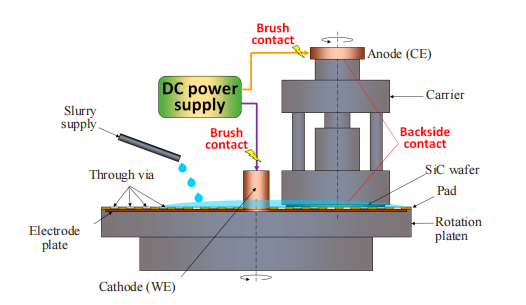SiC掺杂剂选择性光电化学蚀刻
Single crystalline 4H-SiC is a wide-gap semiconductor with optical properties that are poised to enable new applications in MEMS and quantum devices. A number of key hurdles remain with respect to the micro and nano-fabrication of SiC to prepare precise photonic structures with nanometer-scale precision. These challenges include development of a fast, scalable etching process for SiC capable of producing a sub-nanometer roughness semiconductor surface while simultaneously reducing the total thickness variation across a wafer. Our investigation into UV photoelectrochemical processing of SiC reveals high dopant-type selectivity and the advantage of multiple etch stops to reduce layer thickness variation.

We demonstrate dopant-type selectivities >20:1 using a single step and a >100x reduction in surface variation by combining two etch stops. Moreover, the etch rate is fast (>4 μm h−1) and the etched surface is smooth (∼1 nm RMS). These results demonstrate a scalable path to the fabrication of precise nanoscale SiC structures and electronic devices that will enable the next generation of MEMS and photonic quantum devices.
用于光子集成电路应用的具有蚀刻面的 InGaN 激光二极管
The main objective of this work is to demonstrate and validate the feasibility of fabricating (Al, In) GaN laser diodes with etched facets. The facets are fabricated using a two-step dry and wet etching process: inductively coupled plasma—reactive ion etching in chlorine, followed by wet etching in tetramethylammonium hydroxide (TMAH). For the dry etching stage, an optimized procedure was used. For the wet etching step, the TMAH temperature was set to a constant value of 80 ◦C, and the only variable parameter was time. The time was divided into individual steps, each of 20 min.

碳化硅化学机械抛光技术最新进展
Silicon Carbide (SiC) as the third generation semiconductor material has a very high surface quality requirement, which is the core index in the engineering application. Chemical Mechanical Polishing (CMP) is the only technology that can realize global flattening and non-damage surfaces at present. In this paper the recent advances in traditional CMP, the effects of slurry, and hybrid CMP of SiC were reviewed. The principles and recent developments of CMP were introduced. Then the influence of various factors of slurry on polishing performance was discussed.

In addition, recent advances in hybrid CMP technologies, such as Electrochemical Mechanical Polishing (ECMP), Photocatalytic Chemical Mechanical Polishing (PCMP), Plasma Assisted Polishing (PAP), Catalyst-Referred Etching (CARE) were reported, especially some efforts to make these technologies environmentally friendly. Finally, some shortcomings of CMP technology in the application of SiC are summarized and prospect its future development trends.
超低损耗 Si3N4 的晶圆级加工
This thesis presents the development of advanced techniques for the waferlevel manufacturing of ultralow-loss Si3N4 devices and approaches to enable their interface with active components like modulators and chip-scale comb sources (microcombs). The investigation covers the tailoring of a waveguide to the functionality required, the wafer-scale manufacturing of Si3N4, and how to overcome the limitations of a single platform on a wafer.

These studies enable high-yield fabrication of microcombs, the integration of two Si3N4 platforms on the same wafer, and a strategy to efficiently couple to an integrated LiNbO3 layer to expand the chip functionality and scale up the complexity of the PIC.
关键词:碳化硅SiC/化学机械抛光CMP / InGaN激光器 /湿法蚀刻氮化镓/氮化镓TMAH/化学刻蚀/晶圆级加工
上一篇: 化学性质和金属杂质分布在多晶体硅材料